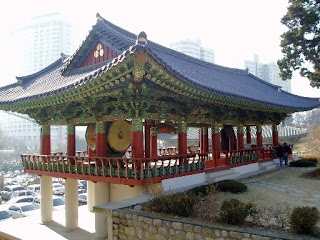
One of the major attractions here is the Aquarium. I’m not that fancy unless I brought my son and wife. The aquarium has a water-tunnel where you can see sharks and tropical fish swim over your head. There are about 40,000 aquatic creatures, which you can view just as if you were actually in the ocean. The Kimchi Museum is a popular place for foreigners; it exhibits about 70 different types of kimchi, pictures, kimchi jars from different districts, and other historical exhibits about kimchi.

The Food Court has a cozy atmosphere, with natural sunlight filtering through the pyramid-shaped glass roof. The glass floor has water flowing underneath it, what a great atmosphere to eat here. Too bad, I’m quite full.
Exterior of Coex Mall



My next destination was Bongeunsa (Bongeun temple) which is located on the slope of Sudo Mountain, across the street from the COEX Mall. The admission fee is free. This temple offering a Temple Stay Program where visitors can lead the life of a monk for few hours. In fact I searched for an overnight stay slightly outskirt of Seoul, but in vain. Because I have to work on most Saturday, this really ruins my plan. Hate it hate it!!!
It was first founded in 794 during the reign of King Wonseong by the monk Yeon-hoe. Bongeunsa was made one of Korea's 14 major temples in 1902. During the Japanese occupation the temple became the headquarters of 80 smaller Buddhist temples around Seoul. As a 1,200 year old temple, Bongeunsa has a variety of large and small buildings.
Jinyeomoon, it’s the main gate of Bongeunsa.


Slightly further down and to the right, there are various pagodas and stone monuments.

Going forward, you will see Bupwangroo where the king and Buddha are placed. It faces the Main Buddha Hall. Now it has become the central religious area where 3300 private Buddha statues are kept.

The side of Bupwangroo

Three-storey stone pagoda located in front of the Main Hall which is a typical style from Unified Shilla Dynasty (668-D). The pagoda is usually located in the same vertical line as the Buddha statue in the Main Hall. I followed the crowds to pay respect to the pagoda by lighting a candle and incense (can be purchased at the vending machine); stood calmly in front of the pagoda and bowed with two palms together. Then I went around the pagoda in the clockwise direction 3 times or more.

Daewoongjeon, Main Buddha Hall is the most important temple in Bongeunsa and is the center for all religious activities. The staircase in front of the building is carved with dragons which were used only in the royal palace.

The side of Daewoongjeon

Jijangjeon, located to the left of Daewoonjeon. Old building with the new skyline structure in the background.

Mireukjeon, The Hall of Maitreya Buddha (The Future Buddha)

In front of the Maitreya Hall stands a 23 meter tall stone statue of the Maitreya Buddha, the tallest of its kind in the country and the greatest treasure of Bongeunsa. People come and pray at the square in front of the Buddha and also used for outdoor performances and ceremonies.


By looking at the exterior of Panjeon or Sutra Hall condition, no doubt it's the oldest building in Bongeunsa which is built in 1855, and holds 3,348 wooden block books that are preserved. The word 'Panjeon' comes from the wooden blocks of Chinese characters used to print Buddhist sutras on paper.

A very old looking bell inside Bell House or Jong-Gak which was built in 1974. This is a typical Korean style bronze bell that is famous for its shape and sound. The bell sound marks the start and finish of daily life in the temple. The bells is always struck 28 times in the morning and 33 times in the evening according to the Buddhist view of the Universe.

Bell pavilion holding four different instruments traditionally sounded before early morning and evening prayers.



From Bongeunsa Temple, I walked almost an hour to Apgujeong Rodeo Street. As you approaching this street, you will see many cafes, theaters, beauty clinics (Seoul is famous for its high-quality plastic surgery) and high-quality foreign branded shops e.g. LV, Gucci, Prada and etc. Due to this atmosphere, this place attracts many youngster and foreigners. If you get lucky, you may meet some famous Korean celebrities as they frequently visits to the area. Seems that I’m not lucky though or I do not know them.

One of the Hooters restaurants in Apgujeong, there’s another one in Gangnam district too.

I took a Line 3 subway back from Apgujeong back to Jongno-3-ga Subway Station. This time I took the other route to Insadong. On the way, I saw this colourful rice cake, mainly used for wedding ceremony and Chuseok festival (Korea Harvest Moon)











This place looks mind-blowing! I have heard good references about Bongeunsa, but I haven't the opportunity to visit it. I just hope to assist for my anniversary.
ReplyDeleteThe best internet website to buy Zoloft at the internet to treat panic. Don't worry your problems with the help of our treatment. Perfect quality products for all customers. 25 mg x 180 pills, 50 mg x 120 pills, 100 mg x 90 pills and other packages can be ordered.
ReplyDelete